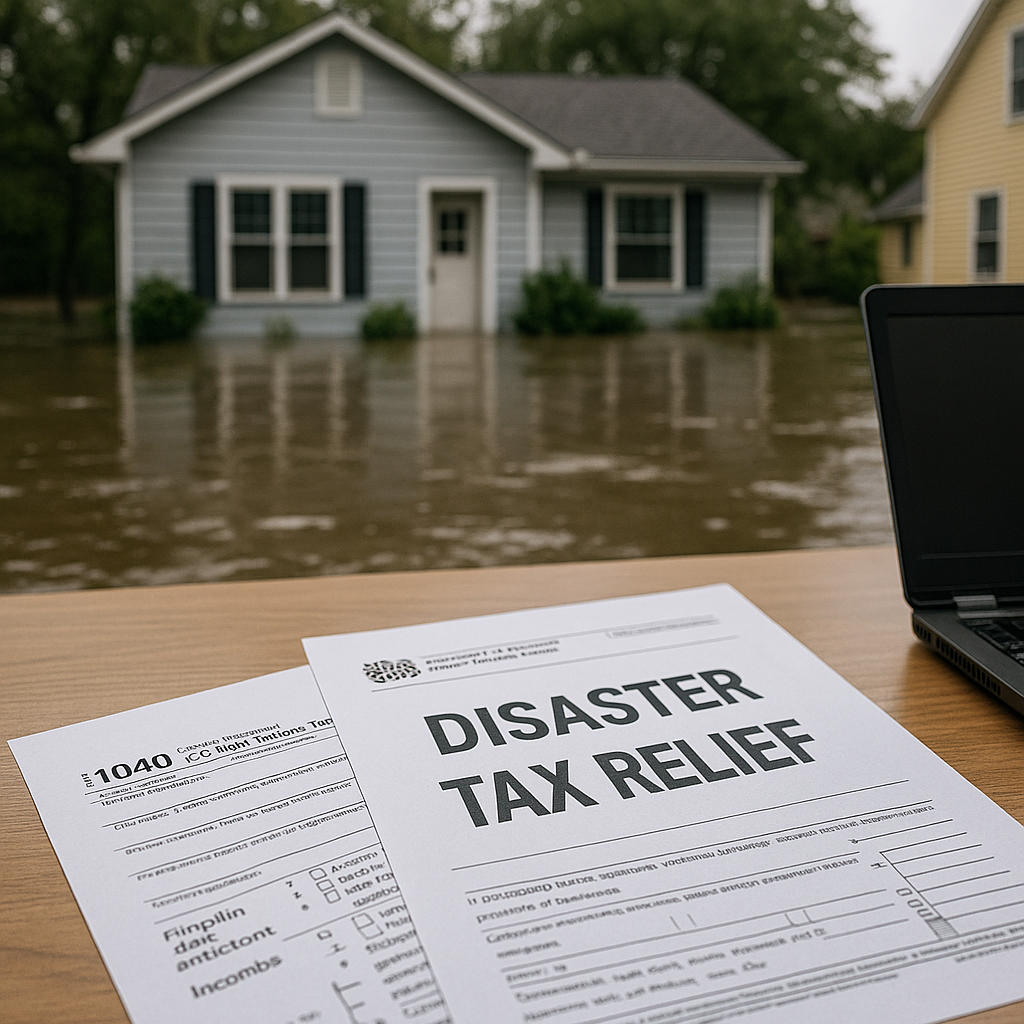
IRS disaster tax relief offers deadline extensions and deductions for taxpayers in federally declared disaster zones.
7 Key Facts About Disaster Tax Relief After Severe Weather
When severe weather strikes — hurricanes, floods, wildfires, tornadoes — the IRS often provides disaster tax relief to help taxpayers recover. These relief measures are designed to reduce immediate financial pressure and ensure individuals, families, and small businesses can focus on rebuilding rather than worrying about looming tax deadlines. Understanding how IRS disaster tax deadline extensions, casualty loss deductions, and other relief provisions work is critical to maximizing benefits after a disaster.
1. IRS Disaster Tax Deadline Extensions
The IRS automatically grants extra time to file returns and make payments when the Federal Emergency Management Agency (FEMA) designates an area as a federal disaster zone. These natural disaster tax extensions apply to both individuals and businesses in affected counties. For example, if a hurricane hit in August, the IRS may extend deadlines that normally fall in September or October well into the following year.
Eligible taxpayers do not need to apply separately for this disaster tax relief. The IRS uses address records and FEMA declarations to automatically apply extensions. You can verify eligibility by reviewing official updates on the IRS Disaster Relief page.
2. Casualty and Theft Loss Deductions
Another cornerstone of disaster tax relief is the ability to deduct casualty and theft losses on your federal return. These deductions apply when property is damaged, destroyed, or stolen during a federally declared disaster. Taxpayers have the option to claim the loss in the year the disaster occurred or the prior year — which may generate a faster refund.
- Example: A family whose home was damaged by a hurricane in 2025 could amend their 2024 return to claim the loss immediately rather than waiting until 2026.
- Documentation is key: photos, insurance statements, contractor estimates, and receipts must support the claim.
3. Penalty Relief for Missed Payments
Taxpayers who cannot make timely payments due to a natural disaster often qualify for penalty waivers. While interest typically still accrues on unpaid balances, the IRS suspends failure-to-file and failure-to-pay penalties for those in federally declared disaster zones. This form of disaster tax relief prevents additional financial strain during recovery.
4. Special Retirement Account Withdrawals
In past major disasters, Congress has authorized penalty-free early withdrawals from retirement accounts like IRAs and 401(k)s. These provisions allow affected taxpayers to access needed cash without facing the usual 10% penalty. Additionally, income from withdrawals can sometimes be spread over three years, or taxpayers may repay the distribution to avoid long-term tax costs. While not automatic, these measures have been common after hurricanes and wildfires.
5. Small Business Disaster Relief
Small businesses often face the hardest financial losses after a disaster. IRS disaster tax relief for businesses can include extended filing deadlines, deductions for damaged property, and inventory write-offs. In addition, the Small Business Administration (SBA) frequently offers low-interest loans for recovery efforts. Business owners with side hustle income should also track disaster-related losses carefully to ensure accurate reporting on Schedule C.
6. Refunds and Amended Returns
Quick access to refunds can be vital after severe weather. Filing an amended return using Form 1040-X allows taxpayers to apply disaster-related losses to the prior tax year, which can result in faster relief. The IRS typically expedites processing for amended returns tied to federally declared disasters, helping taxpayers recover funds sooner.
7. Practical Steps to Take After a Disaster
Maximizing disaster tax relief requires preparation and documentation. Here are essential steps:
- Check IRS Disaster Announcements: Visit the IRS Disaster Relief page regularly for updates.
- Document All Losses: Maintain records of property damage, insurance claims, and receipts for repairs or replacements.
- Review Prior-Year Options: Consider whether amending your prior return for casualty loss deductions provides faster relief.
- Consult a Tax Professional: Disaster-related deductions can be complex, especially for business owners and gig workers. A tax advisor can ensure you maximize benefits while staying compliant.
Why Understanding Disaster Tax Relief Matters
Recovering from hurricanes, floods, and wildfires is overwhelming, but disaster tax relief provisions exist to ease the financial burden. From IRS disaster tax deadline extensions to casualty loss deductions and small business relief programs, these measures provide critical support when it is needed most. Being proactive and informed helps taxpayers avoid penalties, claim rightful deductions, and access refunds more quickly.
For additional strategies on staying tax-ready during unpredictable events, explore our guide on side hustle taxes and download our full e-book, The Complete Guide to Building and Taxing Your Side Hustle Right, for year-round tax planning insights.
Disclaimer: The information provided in this blog post is for informational purposes only and should not be construed as legal, tax, or accounting advice. Tax situations are often complex and highly specific to the individual or business. You should contact a qualified tax expert directly to discuss your particular circumstances. Nothing herein is intended to, nor does it, create an attorney-client or advisor-client relationship. For individual guidance, please contact us directly.


